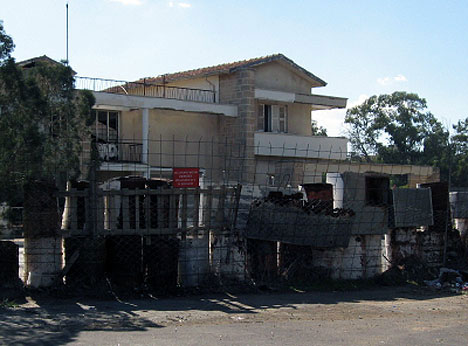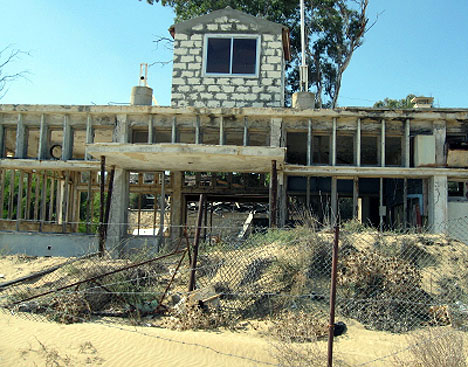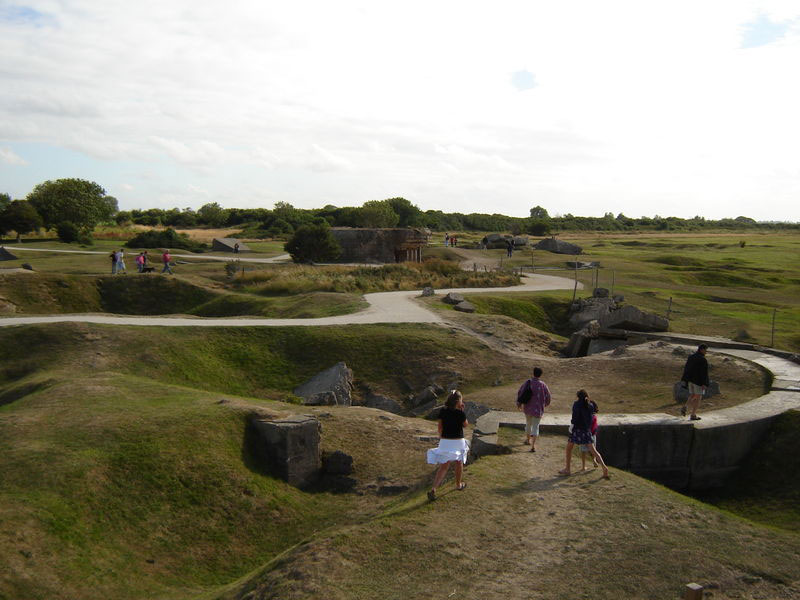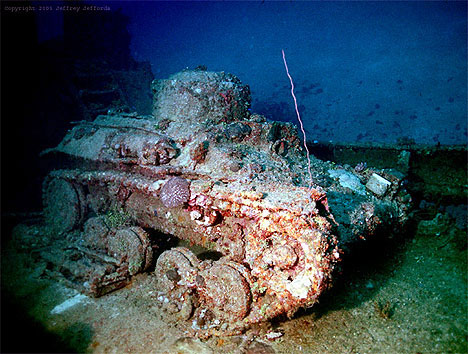
Sometimes it is easy to find the beauty in abandoned buildings and cities, but in many cases the forces driving men from locations are relatively benign; economics, or the environment,
or at worst a toalitarian government attempting to control a population. Man is capable of so much worse, however, and our wars have left abandoned buildings all over the world as haunting memorials to our capacity for violence. Sometimes, what becomes of them after the war is over is even more shameful than the event that brought their destruction about…
Varosha




Images from Michael Totten
Varosha is just noth of the Attilla line in Cyprus, and is the site of brutal Turkish relocation program in 1974. Following the invasion, Turkey immediately forced every Cypriot in the North to relocate South, and vice versa; the Greek Cypriots fleeing the city assumed that they could soon return to their homes; instead, the Turks cordoned it off with barbed wire and patrols, and have left it empty to this day.
Highway 1


Highway 1 is the backbone of Vietnam, and was along the primary axis of the 1975 Easter Offensive that reunified the Southeast Asian nation under Northern leadership. The church visible here was clearly somebody’s last stand, and hasn’t been touched since 1975; the guard towers have been abandoned since the end of the war.
Beelitz Hospital



Images from 28YearsLater
Beelitz hospital was occupied by the Soviet Union from World War II to 1994, Beelitz was constructed as a mental ward in 1900 before becoming a full hospital during World War I. It’s maybe most worth noting that Lance Corporal Adolf Hitler was treated here for battlefield injuries that would win him the Iron Cross.
Mogadishu


Images From Daylife.com
“The Mog” as American soldiers sent there to keep the peace in the early 90s, is one of the most Anarchic locations on earth: racked by famine, and controlled by an ever-rotating warlord at the head of the local authority, the city has been plunged into such chaos since 1991 that the population isn’t know: somewhere between 1.5 and 3 million Somalis are believed to live there.
Talisay City



Images From Found Me
Talisay City in the Phillipenes features a mansion built by a sugar magnate at the turn of the last century that not once, but twice, was destroyed in the Second World War in order to prevent Japanese forces from using it. Once on their way out of the Phillipenes, the USAAF bombed and strafed the home, and Phillipene rebels burned it down to keep it from falling into Japanese hands.
Khe Sahn


Khe Sahn is a remote moutniantop near the Cambodian border in Vietnam, and was a critical airstrip and supply base on what was called the “MacNamara Line” to prevent a larger NVA presence in South Vietnam. In additon to being a Marine Corps stronghold, Khe Sahn was a target for the North Vietnamese because they would soon after its fall be able to take the smaller firebases at Camp Fuller and Razorback; instead the Marines held out for three months before evacuating successfuly. The North Vietnamese later claimed the base, and in honor of their “victory” shipped in wreckage from other battlefields for a display.
Point Du Hoc


Images from wikipedia
Pointe Du Hoc was the key to German defenses on D-Day, and came under hours of pre-landing bombardment from the Allied navies and air forces; nevertheless, the men of the 2nd Ranger Battalion found a fully staffed, functioning fortress at the top of a cliff when they landed, and proceeded to scale ropes so that they could clear out the German crews and use satchel charges to destroy the guns. It was one of the highest-drama moments of the invasion, and is preserved along with the ret of the beach as a memorial.
Barboursville


Images from Virginia Wind
Barboursville is one of the few remaining ruins of the American Civil War. The masion, on the grounds of the vineyards, was designed by Thomas Jefferson before being burned to the ground as Union forces passed through nearby Charlottesville. Presently serving as a museum, Barboursville allows visitors to guid their own tour during operating hours.
Grozny


Image from Flickr User Dziadek
Chechnya, which waged a semi-successful insurgency against Russia over the course of two wars from 1994 to 2000. The capital, Grozny, was attacked by Russian troops almost at will, and much of the infastructure has been destroyed–only to see the population return.
Hue


Hue was the ancient Imperial city of Vietnam; it featured a Forbidden City much like the one surviving in China, laid out along the exact same plans. It stood through the French War, and multiple conflicts with the Chinese, before the Viet Cong holed up there in the aftermath of the Tet Offensive, forcing U.S. Marines to go door-to-door; in one of the most pitched battles of the war, the Marines ended up calling in artillery fire, laying waste to an area that is still being restored today.
Belleau Wood


Images From Herrick Report
Belleau Wood, a forest in France famous for a clash in between German Stormtroopers and U.S. Marines in the first World War, was actually a battle between two U.S. Divisions and five of their German counterparts. In a pitched battle between the 1st and 26th of June, a new record for rate of casualties was set by the Americans on the 6th, but persisting, they took the forest on the 26th.
Truk Lagoon



Images from Don Sutherland
Truk, which was billed at the time as the “Japanese Pearl Harbor” was home to five airstips and most of the Japanese fleet when Operation Hailstone began in February 1944. Under aerial bombardment for three straight days, the Japanese stronghold was removed from contention in the war, and most of the ships in her harbor sank to a shallow grave, where today sport divers have easy access to them.
Kabul


Images from Steve on Picasa
Kabul has had the misfortune of being in almost constant conflict since the 1980s; if it wasn’t the Soviets, it was the Taliban, then the Northern Alliance, then the U.S., and now the Taliban again taking out their frustrations on the capital of Afghanistan. Much like Grozny during the Chechen Wars, life is going on in these modern ruins, and the population is simply trying to survive.
Kuwait


Image from JAMD/ViewImages
Most of the action in the Persian Gulf War was in the vast ocean of the desert, and the Iraqi forces cleared out of Kuwait city largely without a fight. Where the damage remains, however, is in the oil fields, which met with a scorched earth policy, and had to in some instances be closed by explosive charge.
Hiroshima


Images from Peace Parks
Hiroshima was of course the site of the first use of an atomic bomb in anger; while most of the city has rebuilt over the clear-cut blast radius, a lone building remains standing as a memorial to the vaporization of a city in 1945.
Source
No comments:
Post a Comment